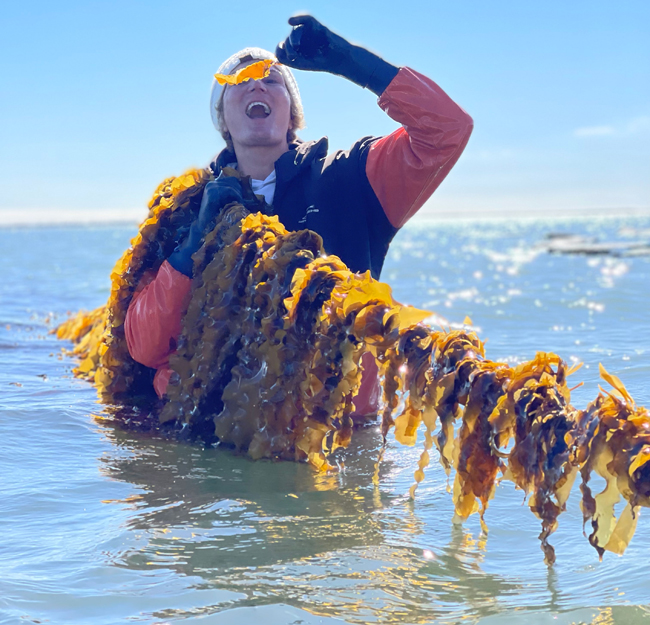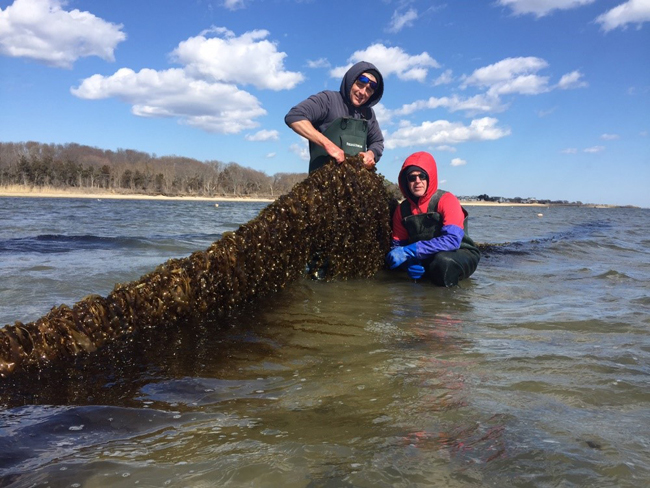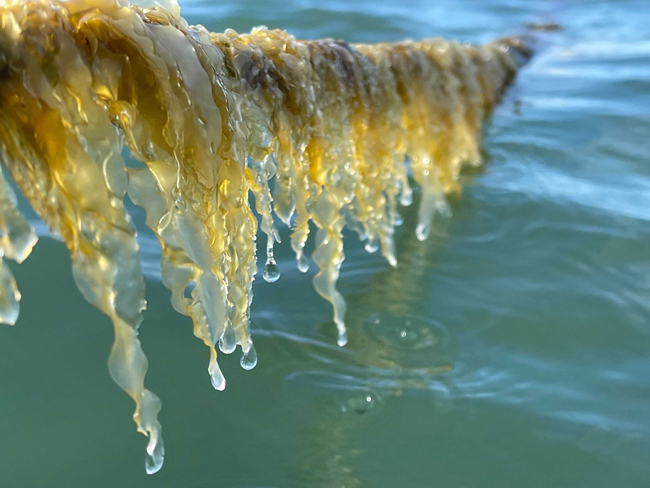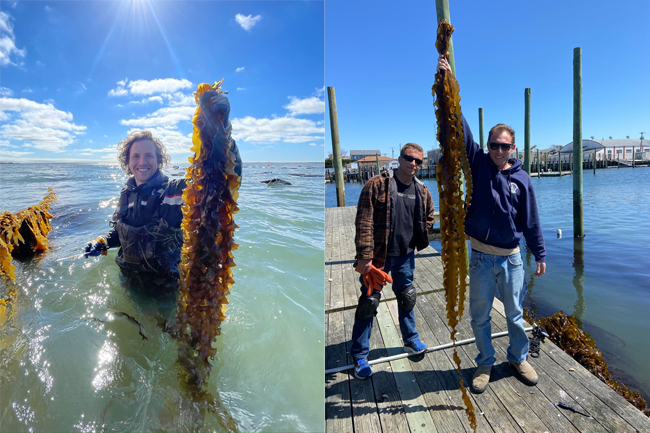
On harvest day, kelp and oyster farmer and former W.N.B.A. Hall of Fame basketball player Sue Wicks poses playfully with sugar kelp, which is edible. Credit: Coco Teodoro
— By Chris Gonzales, Freelance Science Writer, New York Sea Grant
Stony Brook, NY, August 24, 2023 - It’s a problem as serious as climate change, but less well-known: Too much carbon dioxide is entering our oceans, which increases the water’s acidity, a process also known as ocean acidification. Additionally, carbon dioxide in our planet’s atmosphere (and absorbed by its waters) has a warming effect, causing climate change.1
Ocean acidification particularly harms shellfish and puts at risk a potentially huge range of marine life. But researchers have discovered a versatile solution in a common seaweed — kelp.
The deployment of kelp on an oyster farm combats ocean acidification and therefore helps protect bivalves. The process may also have additional ecosystem benefits, including the extraction of carbon and nitrogen, and protection against harmful algal blooms (HABs).
“This [problem] also affects lobsters and crabs,” said ecologist Christopher Gobler of Stony Brook University (SBU)’s School of Marine and Atmospheric Sciences (SoMAS). “Making shells becomes more difficult as the levels of carbon dioxide increase in our atmosphere and in our oceans.”

SBU SoMAS’ Mike Doall and oyster farmer Paul McCormick show off the kelp grown on the Great Gun oyster farm. Credit: Christopher Gobler, SoMAS, Stony Brook University
Saccharina latissima (sugar kelp) is a macroalgae that can be found across the North Atlantic, Pacific, and Arctic oceans. In recent years, people have been studying these algae, and other kelp, for their commercial importance, often for fertilizer or food, as well as for their environmental benefits. Kelp is a proven fighter against the carbon dioxide that causes climate change and ocean acidification, as well as the nitrogen that leads to HABs. These algae can extract these elements from the sea, making the water clearer and reducing its acidity.
However, scientists are only now beginning to study the beneficial effects of algae and kelp on other marine life, particularly bivalves such as mussels and oysters. Gobler and colleagues cultivated bivalves (specifically, hard clams, eastern oysters, and blue mussels) with sugar kelp in the lab and on a coastal shellfish farm.2
This study is one among many underway in which scientists are trying to deal with a four-fold threat facing the world’s oceans: acidification, warming, HABs, and hypoxia.

(At left) In the lab, researchers Alice Jenks and Amanda Shore do a closer inspection of the sugar kelp they’ve gathered. Credit: Coco Teodoro; (At right) Sugar kelp can grow quickly in colder months. Credit: Mike Martinsen
Protection for Shellfish
In the study by Gobler and colleagues, bivalves that were exposed to sugar kelp didn’t suffer the same negative effects of exposure to high carbon dioxide. The kelp reduced the water’s acidity, making it healthier for the bivalves. Also, chemically speaking, it changed the carbonate levels, making more carbonate available for the production of shell material. In short, the bivalves grew larger and were healthier. Gobler’s team also demonstrated that kelp could grow surprisingly well in shallow waters, a revelation given that kelp generally grows in deeper waters.
“We are excited by the prospect of creating a ‘halo effect’ for bivalve aquaculture whereby seaweeds can be grown on bivalve farms to locally reduce the intensity of HABs and acidification to protect shellfish and benefit growers,” said Gobler.
Growing kelp with oysters gives these farmers one more reason to add to their operations a commodity already widely used in products from skin care to fertilizers. Some restaurants feature it on the menu. Sugar kelp is widely used as a food and soil amendment and has also shown promise as a potential substitute for synthetic fibers and plastic packaging.
Studies done at the Gobler Lab and funded by New York Sea Grant (NYSG) are on the leading edge of these new efforts.

Sugar kelp can live for two to four years. Credit: Mike Martinsen
Over the past four years, Gobler’s lab has cultivated sugar kelp on 12 different oyster farms, producing 10,000 pounds of kelp while removing 36 pounds of nitrogen.3
Meanwhile, the state government has started providing sugar kelp, free of charge, to local farmers, organizations, and businesses who want to experiment with using it.
“Since the initiation of New York Sea Grant’s Seaweed Processing and Marketing Task Force in 2021, the program has been actively working with local, regional, and national partners like Lazy Point Farms to provide resources and technical assistance for the emerging seaweed industry on Long Island,” said Michael Ciaramella, NYSG’s seafood specialist. The idea is to help businesses investigate the potential of sugar kelp for both food and non-food uses.

Caused by the Aureococcus anophagefferens alga, this brown tide in the waters of Long Island's Great South Bay near Patchogue (observed by the Gobler Laboratory on June 23, 2021) is highly damaging to marine life, especially eelgrass that fish and shellfish depend on for habitat. Credit: Christopher Gobler, SoMAS, Stony Brook University
More Prevalent HABs
Like the threat of ocean acidification, another big issue for our oceans is the rise of HABs. With increasing frequency, the water becomes cloudy with microorganisms that can be dangerous to marine and human life. At any given time, numerous studies and projects are underway at the Gobler Lab, often with funding from NYSG, as scientists work to reduce the negative effects of HABs. One of the most noted culprits of HABs is Aureococcus anophagefferens, a type of microalgae that causes brown tide.
While not harmful to humans, brown tides can harm shellfish such as bay scallops and blue mussels—which cannot swim away—and weaken eelgrass, which can suffer from lack of light caused by brown tides. Fish tend to avoid brown tide areas if they can, if concentrations of the organism aren’t too high. Brown tides can deter recreational use of the water for swimming, boating, and fishing.4
While some coastal communities may try to use algal biocides (chemicals) to try to fight HABs, these can have harmful side-effects in the environment.5
This makes scientists curious when competing species of macroalgae appear on the scene. In a series of experiments, scientists led by Gobler found that Gracilaria tikvahiae and Dasysiphonia japonica reduced concentrations of the harmful A. anophagefferens microalgae.6 Another species, Ulva spp., had some algacidal properties, though not as strong. Seaweeds also remove nitrogen and other nutrients from the water, making it clearer and more healthful to life. These anti-algal properties, combined with the macroalgae’s ability to remove nutrients, can turn the tables against brown tides.
But don’t jump in the water just yet. Cultivation of Dasysiphonia japonica is not something scientists consider since it is harmful to juvenile fish and shellfish, and spreads aggressively, causing environmental problems of its own. Cultivation of G. tikvahiae might be possible, but the grower will need to make sure she has the right species, because it is morphologically indistinguishable from Agarophyton vermiculophyllum, a pest, except at the molecular level. Thus, with new arrivals such as Dasysiphonia, the picture gets complex very quickly.
Still, scientists believe the rapid spread of Dasysiphonia in New York estuaries, especially in Great South Bay, may be influencing the patterns of brown tide occurrence, potentially causing shorter and less intense brown tide blooms.

Sugar kelp, Saccharina latissima. Credit: Kyle Majid
Kelp Reduces Another Cause of HABs
In a different study to evaluate the potential of macroalgae to mitigate another type of algal bloom—this one Alexandrium catenella—scientists measured the effects of cultivating three types of macroalgae in their presence: Saccharina latissima (sugar kelp), Chondrus crispus (Irish moss), and Ulva spp.7
All three of these species (except low levels of C. crispus) brought about significant reductions in A. catenella densities. But sugar kelp inhibited the blooms to the greatest extent.
Alexandrium catenella is a HAB-forming dinoflagellate that produces saxitoxins—toxins that accumulate in shellfish and can result in paralytic shellfish poisoning. It’s a human health hazard and can cause significant economic losses when shellfish beds and farms are forced to close.

(At left) Displaying a bounty of kelp on harvest day. Credit: Coco Teodoro; (At right) Sugar kelp can grow up to 16 feet long. Credit: Kyle Majid
Looking Ahead
Thus, in experiments with sugar kelp, bivalve growth rates significantly increased. Kelp reduces the water’s acidity, and extracts carbon dioxide, a cause of acidification, and nitrogen, a cause of HABs.
Gobler and colleagues believe that in addition to buffering carbonate chemistry, kelp detritus is a potential food source for bivalves. Thus, not only does kelp ease the acidity of the water, but it can also provide nutrition for bivalves.
Even so, there is evidence that sugar kelp is declining due to warming oceans. The decline also could be due to an increase in the number of fish that are kelp grazers because the predators that eat them have been overfished. However, the increased growth rates that kelp enjoy due to elevated carbon dioxide may counteract these processes.
This is good news for people who grow kelp on shellfish farms. The purposeful cultivation of kelp on bivalve farms may improve their growth rates and overall health, in addition to providing better water quality.
References
1 Global Climate Change, NASA
2 Young CS, Sylvers LH, Tomasetti SJ, Lundstrom A, Schenone C, Doall MH and Gobler CJ (2022) Kelp (Saccharina latissima) Mitigates Coastal Ocean Acidification and Increases the Growth of North Atlantic Bivalves in Lab Experiments and on an Oyster Farm. Frontiers in Marine Science. 9:881254. http://dx.doi.org/10.3389/fmars.2022.881254
3 In Media: Cultivating Kelp Will Help Cut Down Nitrogen in Local Waters
4 Brown Tide Impacts, Harmful Algal Blooms in Maryland, Maryland Department of Natural Resources
5 Benitt, C., Young, C., Sylvers, L., & Gobler, C. (2022). “Inhibition of harmful algal blooms caused by Aureococcus anophagefferens (Pelagophyceae) using native (Gracilaria tikvahiae) and invasive (Dasysiphonia japonica) red seaweeds from North America.” Journal of Applied Phycology (2022) 34:965–983. https://doi.org/10.1007/s10811-021-02677-9
6 Ibid.
7 Sylvers, L., & Gobler, C. (2021). Mitigation of harmful algal blooms caused by Alexandrium catenella and reduction in saxitoxin accumulation in bivalves using cultivable seaweeds. Harmful Algae 105 102056 https://doi.org/10.1016/j.hal.2021.102056
More Info: New York Sea Grant
New York Sea Grant (NYSG), a cooperative program of Cornell University
and the State University of New York (SUNY), is one of 34 university-based
programs under the National Oceanic and Atmospheric Administration’s
National Sea Grant College Program.
Since 1971, NYSG has represented a statewide network of integrated
research, education and extension services promoting coastal community
economic vitality, environmental sustainability and citizen awareness
and understanding about the State’s marine and Great Lakes resources.
Through NYSG’s efforts, the combined talents of university scientists
and extension specialists help develop and transfer science-based
information to many coastal user groups—businesses and industries,
federal, state and local government decision-makers and agency managers,
educators, the media and the interested public.
The program maintains Great Lakes offices at Cornell University, SUNY
Buffalo, SUNY Oswego and the Wayne County Cooperative Extension office
in Newark. In the State's marine waters, NYSG has offices at Stony Brook
University and with Cornell Cooperative Extension of Nassau County on Long Island, Brooklyn College and Cornell Cooperative
Extension in NYC and Kingston in the Hudson Valley.
For updates on Sea Grant activities: www.nyseagrant.org has RSS, Facebook, Twitter, Instagram, and YouTube links. NYSG offers a free e-list sign up via www.nyseagrant.org/nycoastlines for its flagship publication, NY Coastlines/Currents, which is published quarterly.